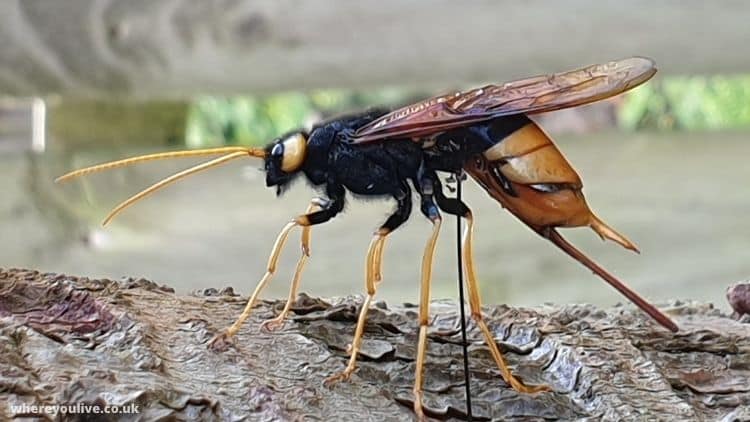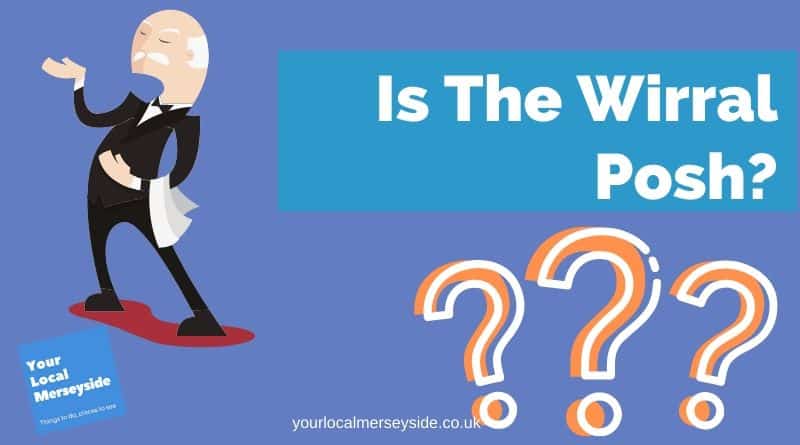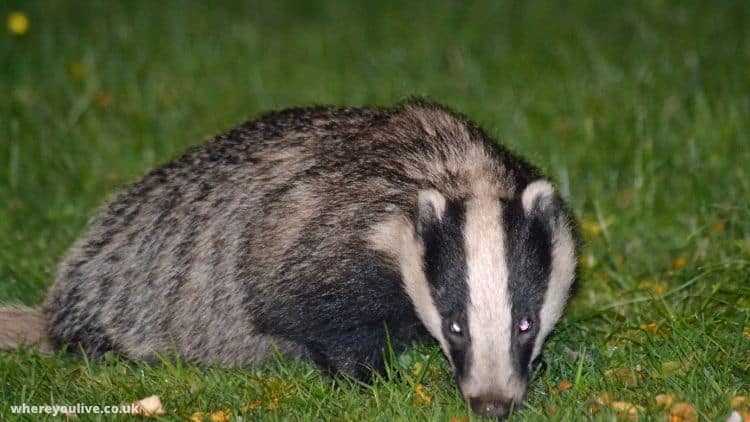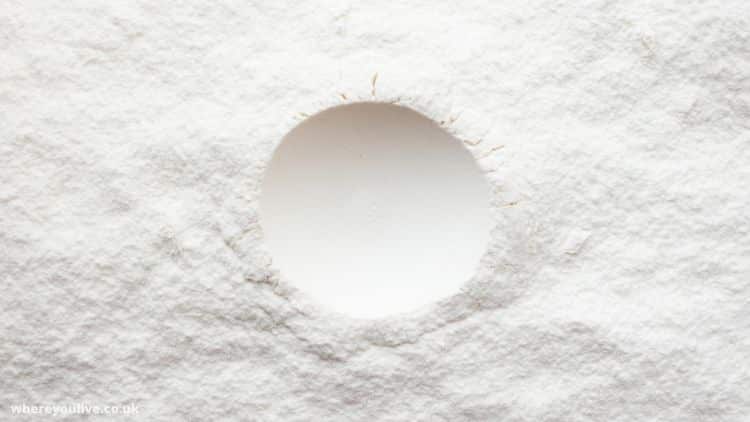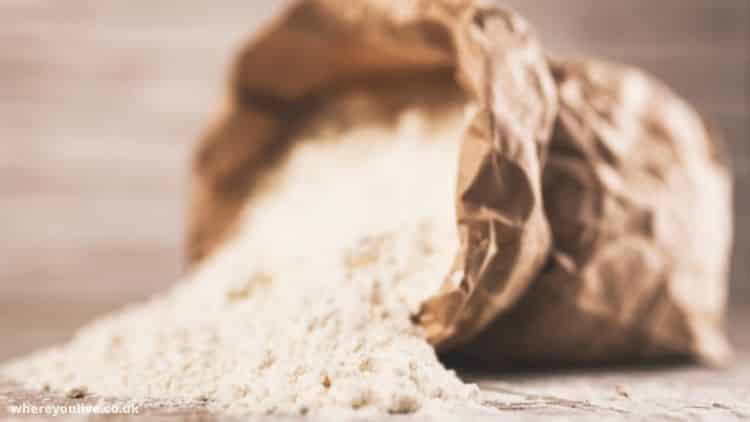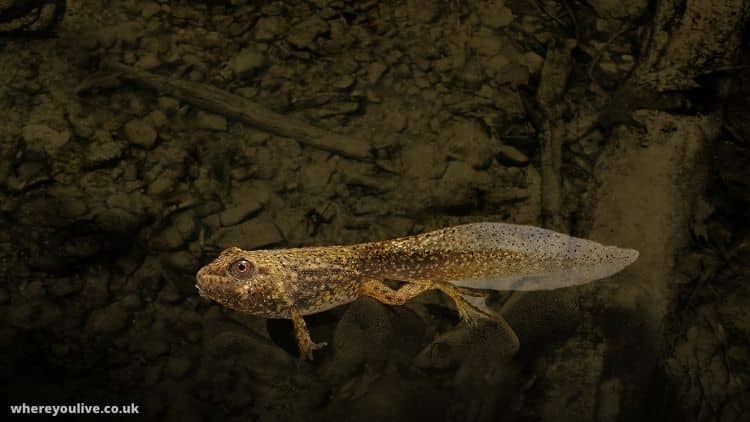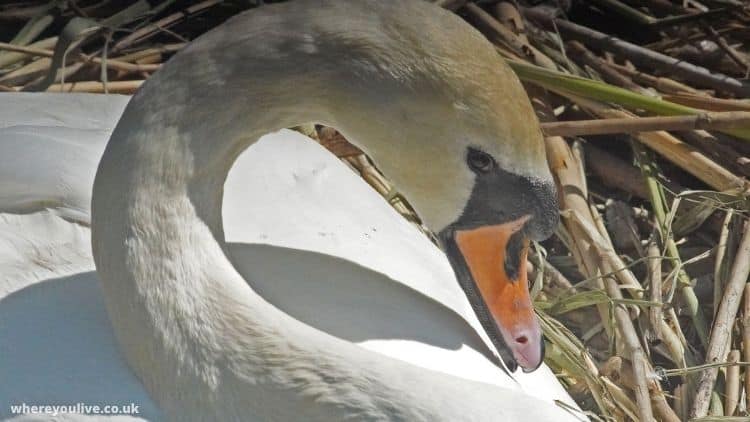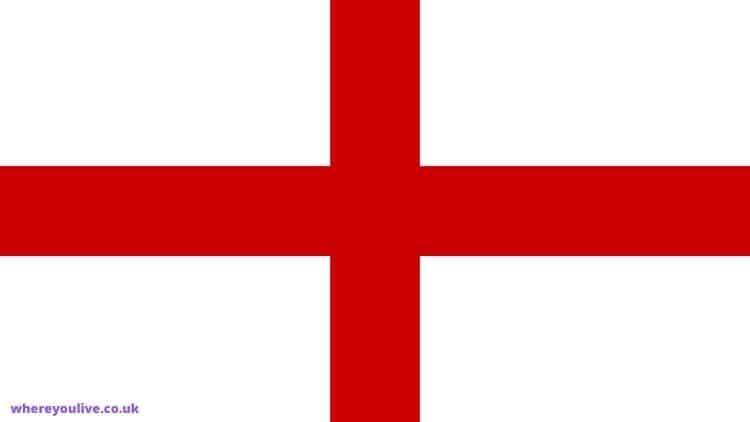The wood wasp is a large, long insect. It has bright orange and black striped colours with two yellow spots on the abdomen. The wood wasp builds its nests in trees or wood that conifers up to 30 meters high including pine, fir and cedar (woodwasp). They’re typically found near rivers where they can find the wood that they need to build their nests.
Statistics
Up to 4cm in length
Conservation status
Common.
When to see
May to August
It’s also known as the ‘giant woodwasp’ or ‘greater horntail wasp’.
The giant horntail is a massive sawfly that lives in wood. A relative of the wasps, this female has black and yellow skin with a long stinger-like ovipositor to lay eggs into pine trees. This is typically found in coniferous eroded forests.
The large stings are in fact the oviplanator that serves to lay eggs. The large size black or yellow colour means that this ‘wasp’ causes more than some scares but it’s nothing more than a sawfly.
The wood wasp is not a woodworm, but it can still be destructive and cause damage. It gets its name from the way that it drills into the wood with its long ovipositor to lay eggs. The female wood wasp lays her eggs in dead or dying trees including pine trees, spruce and fir trees. When the wood wasp eggs hatch, woodpeckers feed on the larvae.
The wood wasp is not a serious tree pest if it’s left alone and does no harm to trees; however, wood may be weakened by excessive egg-laying. A major infestation of wood wasps can kill the pine trees that they are feeding off causing them to fall down.
When are wood wasps active?
The wood wasp is active in the summer and early autumn. This species can be seen on warm, sunny days between May to August and from July through September depending on location.
What damage do wood wasps cause?
Wood wasp-infested trees were cut to create rafters that were used to manufacture a roof structure.
Infestation cannot be treated as wasp attacks do not affect healthy trees and newly felled wood because it requires moisture to form. Once the wood is removed it’s not likely for re-infestation because it’s too dry to occur.
Does a wood wasp sting?
Although wood wasps are not aggressive; if you do get stung, it can be painful. Like bees, wood wasps have venomous stingers to protect themselves that cause pain when the insect strikes and injects its venom into your skin.
Can Horntail Wasps sting?
We’ve included this question because people often ask this as an alternative to using the description wood wasp. Yes, Horntail Wasps sting. Horntail wood wasps are very rarely aggressive and stinging is rare. However, if you do get attacked by a wood wasp it can be painful because of the venomous stingers that woodwasps have which inject their poison into your skin.
Do you get wood wasps in the UK?
Yes, you do get them here in the UK. Because they resemble wasps but are significantly bigger, wood wasps are frequently mistaken for hornets. They’re occasionally known as ‘Giant Horntails’ for obvious reasons. The wood wasps are less aggressive than hornets and they’re not known to sting unless provoked.
How do I treat a wood wasp infestation?
There is no treatment for wood wasp infestation as the wood itself is dead, so it’s best to remove wood that has been affected by woodwasp. In wood that is still alive, wood wasp larvae are removed by using a chemical spray.
Can wood wasp damage my roof?
Yes, woodwasp can cause major wood damage to roofs, as wood wasp larvae have a tendency to burrow into wood. This is most commonly seen in wood that has been affected by woodwasp and the larvae come out at night and feed on new wood leaving burr holes (see below). These are tell-tale signs of woodwasp infestation.
How big do wood wasps get?
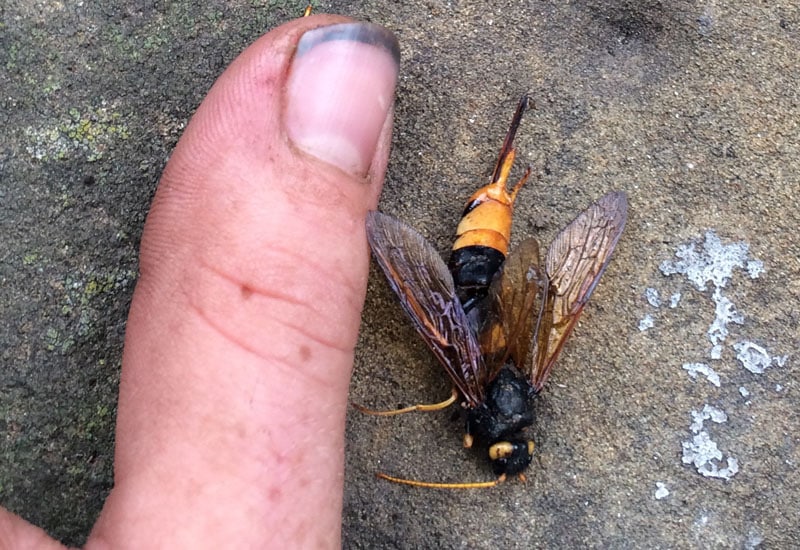
They have a body length of around 25mm and they can grow to about 50mm long with wings extended. It’s easy to identify woodwasp as it has an ovipositor that is longer than its body (oviposito=egg laying). This
When woodwasps have laid their eggs in the wood, they tend not to leave it after this and die off as well.
How do I get rid of wood wasps here in the UK?
It’s best to remove wood that has been affected by woodwasp and treat wood still intact. You can use a chemical spray for woodwasps on wood that is still alive but you need to get rid of infested wood if it’s not possible, then the safest option would be to hire a pest control company rather than tackle it yourself.
What is a very large wasp called?
We’ve included this question because a lot of people ask it. The answer is you have probably found a Wood Wasp.
What can I spray on wood to keep wasps away?
There is no treatment for wood wasp infestation as the wood itself is dead, so it’s best to remove wood that has been affected by woodwasp. In wood that still alive woodwasps can be removed using chemical sprays which are made specifically for this purpose.
You need to treat around window and door frames etc., in wood that is woodwasp-infested. You need to treat the wood around all areas of wood in which you see wood wasp activity and also under eaves, window sills etc., where woodwasps may be entering your home or building.
It may be worth contacting the professionals who will give you the best advice and help you further.
Do wasps like rotting wood?
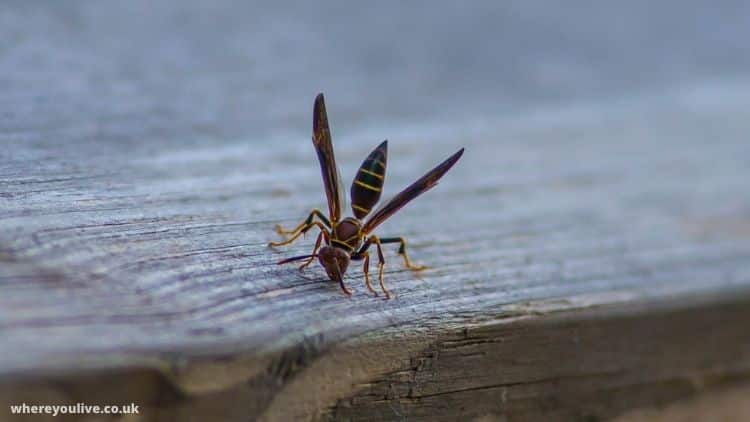
Wasps prefer living in decaying trees, stumps and logs but can also be found under roofs etc., where it’s darker or more humid. They prefer wood that is already damp and decaying rather than freshly cut wood.
Is wood wasp considered an endangered species?
Wood wasps are not on the list of Britain’s rarest invertebrates, but they aren’t common by any means either and seem to be in decline which may make them a candidate for consideration as an endangered species in the future.
What wood wasps are common in the UK?
All woodwasps found here are of one single genus, Urocerus which is also known as horntails or wood wasp due to their ovipositor that looks like a tail with an arrowhead at the end. They may not be the only wood wasps found in the UK but they are still commonly seen.
How do wood wasps make their nests?
Woodwasps use wood to build their nests by chewing it off and turning it into pulp which is then chewed up some more until it’s a fine sawdust-like substance, this allows them to be able to construct their wood nest.
Wood wasps are considered beneficial because they help break down wood and wood waste, but if you have wood infested with woodwasps it’s best not to burn the wood as this can cause them to spread via smoke particles.
How long do wood wasp live?
The horntail wood wasp is the most common woodwasp in Britain and it may live for around two years.
How big are wood wasps compared to other types of wasps?
The species that can be seen from March – June here, Urocerus gigas (L.), has a body length of about 25mm whereas bumblebees can be around 20mm.
Hornets are about 22-25mm while the much rarer European hornet (Vespa crabro L.) is slightly bigger at 25 – 30mm.
Where do wood wasps come from?
The woodwasp or horntail as it’s also known comes mainly from Europe.
What wood wasps are found in North America?
There are very few woodwasps that live in North America but the most common is Urocerus albicornis (F.) which has a body length of 20mm. It’s similar to the woodwasp you’ll find in the UK except it only lives for one year.
How many wood wasps are there in the UK?
There is only one woodwasp species in the UK but it has around 25 different types of subspecies which can vary widely across the country so you won’t really know what type you’re dealing with until expert opinion has been given.
When woodwasps attack… they have a sting!
Woodwasps are not aggressive and only sting when they feel threatened or you try to squash them. They do have a strong venom that can be very painful so best to avoid having wood wasp nests in your property altogether. If you’re unlucky enough, (or brave) here’s what you should expect as a woodwasp sting.
The woodwasp may have a body length of 25mm which might seem quite big but its stinger is only around half that size and when it has been to use it, you’ll feel the pain for anything between 15-20 minutes because wood wasp venom contains histamine. The sting will be very painful at first then it will turn into a burning sensation.
What do wood wasps like to eat?
Woodwasps prefer wood that is damp and decaying rather than freshly cut wood so they are unlikely to attack recently treated timber or wood in well-maintained buildings. If there’s an infestation, it may be worth contacting the professionals who will give you a wood treatment to protect your wood and prevent wood wasps from being attracted.
How do you get rid of wood-boring wasps?
The wood boring wasps that you’ll find in UK are usually considered beneficial as they help to break down wood, but if the wood is being attacked by woodwasps it’s best not to burn the wood and hope for the best. If there’s an infestation of horntail woodwasp then you should contact a professional who will give you wood treatment to protect your wood.
What smell do wasps hate?
There are a number of smells woodwasps hate. One is lemon and the other is wood vinegar which can be diluted with water at a ratio of one part wood vinegar to five parts water, then sprayed onto wood wasp nests in springtime when their activity begins.
How does vinegar get rid of wasps?
Vinegar is an acetic acid that woodwasps hate, so spraying diluted wood vinegar onto the wood will help deter wood wasps. At this time of year (spring), horntail woodwasp activity begins and they’re looking for suitable places to build their nests. Woodvinegar works well in getting rid of them.

